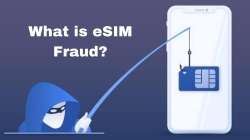eSIM is one of the new technologies that has started gaining traction as various telecom operators such as Airtel, Jio and Vodafone have started providing people with the option to go for one. However, the new trend is also prone to fraudulent activities that can steal your money. Read on to what an eSIM fraud is and how you can remain safe from it.
eSIM fraud: What is it?
For starters, an eSIM is an embedded SIM that is built into a smartphone. It dismisses the need for a physical SIM, however, works exactly like it. It doesn't require a standalone slot in your smartphone, hence, saves some space for more battery or thinner phones. This also works well for wearables such as a smartwatch.
eSIM fraud has started becoming popular and the Hyderabad cyber crime police recently even warned about the growing eSIM swapping fraud. It is suggested that users are receiving a message stating that their SIM card will be blocked in 24 hours if the KYC details aren't updated. Following this, the fraudsters contact people under the garb of customer care executives of any of the telecom operators that provide eSIM services.
Users are then asked to forward an email ID (sent by the fraudsters) to the customer card of that particular telecom operator. The email ID belongs to the scamsters so that they can register their mail IDs to access the user's bank information. Once the message is sent, an auto-generated message is received regarding the eSIM activation, following which another message is received that contains a link to a Google form asking users to fill in details for the KYC updating.
Once users fill in their personal details that also include the bank account number, the eSIM is activated and a QR code is sent to the fraudsters (via email) for them to access the user's phone number as the physical SIM card gets blocked. This way, the scamsters can use the phone number to get OTPs and enter the banking details in e-wallets to steal money from people.
eSIM fraud: How to remain safe?
To stay safe from such online scams, you must stop believing the fraudulent messages they receive. If anyone fishy calls you asking for your information to update your KYC, DO NOT provide any information to the person. Instead, call the actual customer care number and ensure your phone number is safe. Additionally, refrain from sharing your banking details with anyone, be it via a Google form or someone over a call.
If you have fallen prey to an eSIM fraud, immediately contact the customer care to stop the eSIM activation process.
Latest technology reviews, news and more

